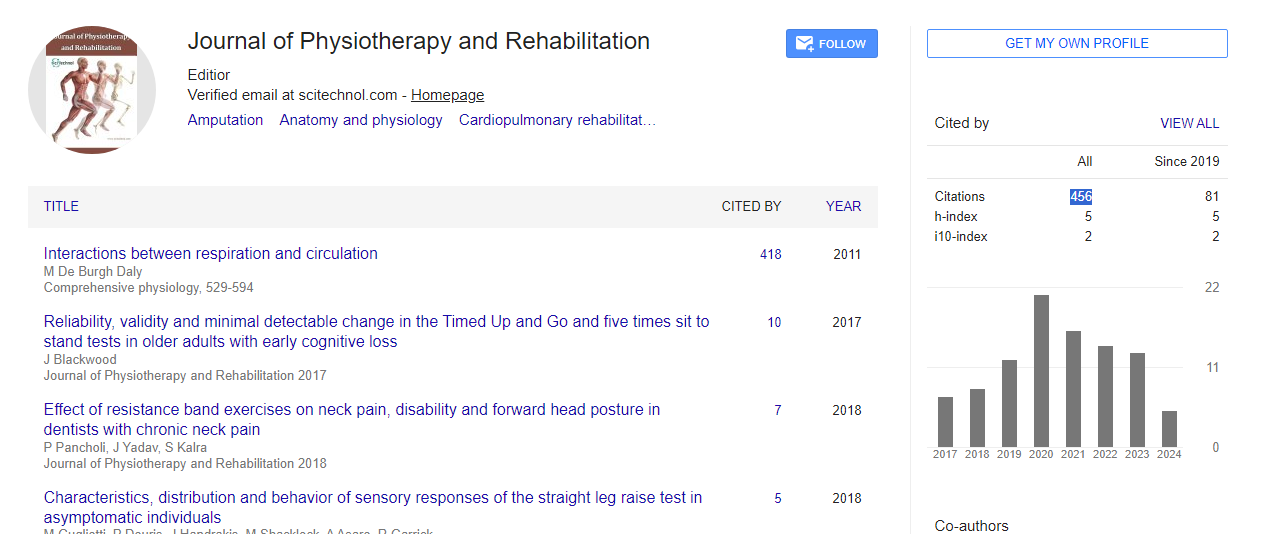Opinion Article, J Physiother Rehabi Vol: 8 Issue: 4
Science of Recovery: How Bio-Mechanisms Influence Rehabilitation and Healing Processes
Kourzine Fini*
1Department of Physical Rehabilitation, CHRU Brest, Brest, France
*Corresponding Author: Kourzine Fini,
Department of Physical Rehabilitation,
CHRU Brest, Brest, France
E-mail: finikou@zine.edu.fr
Received date: 23 July, 2024, Manuscript No. JPTR-24-147325
Editor assigned date: 25 July, 2024, PreQC No. JPTR-24-147325 (PQ);
Reviewed date: 08 August, 2024, QC No. JPTR-24-147325
Revised date: 15 August, 2024, Manuscript No. JPTR-24-147325 (R);
Published date: 22 August 2024, DOI: 10.4172/JPTR.1000181.
Citation: Fini K (2024) Science of Recovery: How Bio-Mechanisms Influence Rehabilitation and Healing Processes. J Physiother Rehabi 8:4.
Description
Rehabilitation is important phase in the recovery process following injury, surgery or illness. While traditional rehabilitation focuses on physical therapy and exercise recent advances in medical science have highlighted the importance of understanding the underlying biomechanisms that drive recovery. These bio-mechanisms which include cellular, molecular and physiological processes play an essential role in how the body heals and regains function. At the heart of rehabilitation lies the complex cooperation of cellular and molecular mechanisms that facilitate tissue repair and recovery. When an injury occurs the body initiates a complex series of events starting with the inflammatory response. This phase is characterized by the release of cytokines and growth factors that attract immune cells to the site of injury initiating the process of clearing damaged tissue and clear the way for healing.
One of the key players in this process is the fibroblast, a type of cell that produces collagen and other extracellular matrix components essential for tissue repair. The proliferation and activity of fibroblasts are regulated by various signaling pathways, including those mediated by Transforming Growth Factor-Beta (TGF-β) and Platelet-Derived Growth Factor (PDGF). Understanding these molecular pathways allows clinicians to develop targeted therapies that can enhance or modulate the healing process, leading to more effective rehabilitation outcomes. Another important aspect of rehabilitation is neuroplasticity the brain's ability to reorganize itself by forming new neural connections. This process is particularly important in patients recovering from neurological injuries such as stroke, spinal cord injury or traumatic brain injury.
Recent studies have shown that specific rehabilitation exercises and therapies can promote neuroplasticity by stimulating the brain's innate ability. For example, Constraint-Induced Movement Therapy (CIMT) encourages the use of the affected limb in stroke patients which in turn strengthens neural pathways and improves motor function. Similarly robotic-assisted rehabilitation and virtual reality-based therapies have been shown to enhance neuroplasticity by providing repetitive taskspecific training that drives neural adaptation. In addition to cellular and molecular mechanisms the biomechanical properties of tissues also play a significant role in rehabilitation. Muscles, tendons and ligaments undergo remodeling in response to mechanical stress, a process known as mechanotransduction.
For instance, Progressive Resistance Training (PRT) is an common rehabilitation strategy that support the principles of mechanotransduction to strengthen muscles and improve functional outcomes. By gradually increasing the load placed on muscles, PRT induces hypertrophy and enhances muscle strength. Similarly, stretching exercises promote flexibility by influencing the biomechanical properties of connective tissues, reducing stiffness and preventing injury.
Conclusion
The science of recovery is increasingly recognizing the importance of bio-mechanisms in shaping rehabilitation and healing processes. By understanding and support these mechanisms, clinicians can develop more targeted and effective rehabilitation strategies that promote optimal recovery. As research in this field continues to advance it is likely that we will see the emergence of new therapies and technologies that further enhance the body's ability to heal and regain function ultimately improving the quality of life for patients undergoing rehabilitation.
 Spanish
Spanish  Chinese
Chinese  Russian
Russian  German
German  French
French  Japanese
Japanese  Portuguese
Portuguese  Hindi
Hindi 